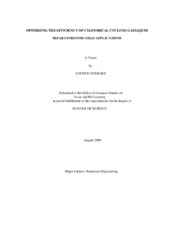| dc.description.abstract | Problems associated with the use of compact cylindrical cyclone gas/liquid (CCGL)
separators can be attributed to two physical phenomena: gas carry-under and liquid carryover
(LCO). Inadequate understanding of the complex multiphase hydrodynamic flow
pattern inside the cylindrical separator has inhibited complete confidence in its design
and use, hence the need for more research.
While many works have been done with a fixed inlet slot to predict the operational
efficiency of the cyclone separator, very little is known about how separator performance
can be influenced due to changes in fluid properties. During the operations of the CCGL
separator the complex flow situations arising from severe foaming within the separator
has not been addressed. Also the effects of emulsion formation under three phase flow
conditions on the properties of cyclone separators are yet to be studied.
An understanding of liquid holdup and hydrodynamic nature of flow in a compact
separator under zero net liquid flow (ZNLF) and zero net gas flow (ZNGF) conditions is
necessary in many field applications, especially for the prediction of LCO and in the
design of the CCGL separators. Also, ZNLF holdup is an important parameter in
predicting bottom-hole pressures in pumping oil wells.
This research investigated the effects of fluid properties such as density, foam and
emulsion formation on ZNLF, zero net gas flow ZNGF, and LCO in compact cyclone
separators; this was achieved by replacing water, which is the conventional fluid used as
the liquid medium in many previous research efforts with a foamy oil while maintaining
air as the gas phase. Variable-inlet-slots that regulate the artificial gravity environment
created by the separator were used to check for improved separator performance. Also experiments to check separator response to a range of water-cut in three-phase flow were
performed. All experiments were carried out under low constant separator pressures.
The ZNLF holdup is observed to decrease as the density of the fluid medium
decreases. Varying the inlet slot configurations and recombination points does not have
any effect on the ZNLF holdup when changes in density of the liquid phase occur.
Comparisons with previous work show that there exists a wide variation in the LCO
operational envelope when severe foaming occurs in the CCGL separator. At high watercut
(greater than 30%), the separator LCO performance was observed to be normal.
However, at water-cut below 30%, LCO was initiated much earlier; this is attributed to
severe foaming in the CCGL separator. | en |


